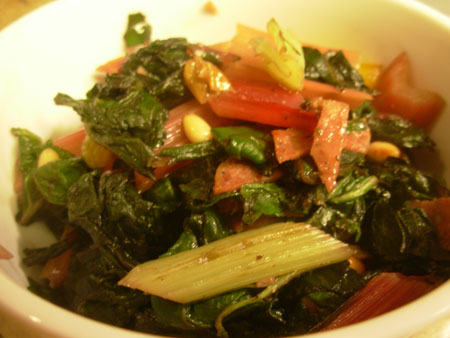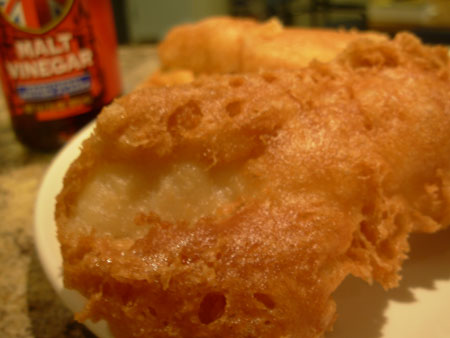(I’m cooking once a week from Thomas Keller’s Ad Hoc at Home cookbook. For more info, read my intro post on the Thomas Keller Challenge.)
This week’s Thomas Keller Challenge entry is a full meal; feeling ambitious, I made a main and a side from the cookbook.
Nobody ever said Chef Keller’s recipes weren’t labor-intensive. When the first step of a vegetable side dish is, “line 3 baking sheets with parchment paper,” that should throw up a red flag. To be honest, Keller’s rainbow chard with raisins, pine nuts, and serrano ham (which NPR published online last November) isn’t that complicated, but that first instruction’s a doozy.
Basically, all the different elements of this dish are prepared separately: You toast the pine nuts, and set aside. You plump the raisins in wine, and set aside. You separate the chard greens from the stems, blanch the stems, and set aside. You wilt the greens, and set aside. Then you crisp the ham and toss everything together. Lots of steps, but none of them terribly difficult.
My CSA gives me a lot of rainbow chard, and I’ve learned to like the stuff, so this recipe was an easy choice. On a few levels, it succeeded: The raisins, soaked in wine, anise, and clove, are a really nice sweet-and-tart contrast to the slight bitterness of the chard, and the idea of cooking the stems separately is definitely inspired—they retain a little bit of crunch but are well cooked, something difficult to do if you cook stems and greens together.
But overall, this dish was kinda blah. The small amounts of raisins, pine nuts, garlic, and ham compared to the chard don’t add enough flavor.
On the other hand, Chef Keller’s fried fish was a great success.
The batter for this fish is made with yeast, which is something I hadn’t ever tried before. (It also makes it time-intensive; the batter has to rise for an hour and a half.) It’s also more evidence for Keller’s obsession with brining meats (he brines just about everything in the book)—the fish soaks in a salt solution for 10 minutes before frying.
This is a great fried-fish recipe. The bubbly yeast batter makes for a thick, crispy coating that’s still delicate and lacy, and it has just a hint of sourdough tanginess that’s perfect. The brine solves a problem I often have with breaded foods—how much do you season the coating to make sure the meat tastes good? With salt already in the fish, the batter doesn’t need much, and even bites of fish with little breading aren’t bland.
You don’t need much by way of toppings, though malt vinegar or tartar sauce aren’t out of place. This is a very fish-and-chips style dish.
Keller calls for petrale or another kind of sole; the closest I could find was flounder, which was perhaps a little delicate for this preparation. You want a firm-ish white fish with thin fillets: Sole would of course work great, but small catfish fillets might be excellent made this way.

